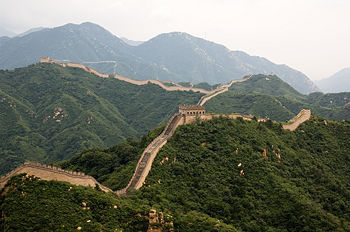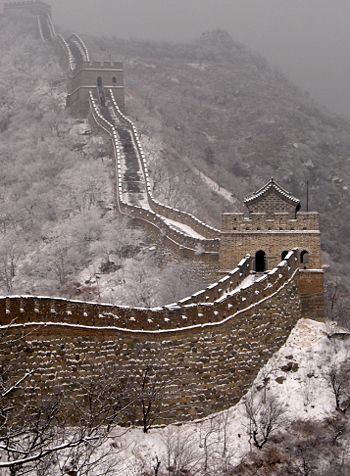Great Wall of China: Difference between revisions
imported>Derek Harkness (→History: add photograph) |
imported>Stephen Ewen m (→Form and construction: fix formatting) |
||
| Line 18: | Line 18: | ||
When the Ming dynasty built their walls, in the main, they opted for stone. The Ming walls were built under the direction of the army. Each division of the army designed their own section of wall. So the exact system of construction varies along the wall's length. | When the Ming dynasty built their walls, in the main, they opted for stone. The Ming walls were built under the direction of the army. Each division of the army designed their own section of wall. So the exact system of construction varies along the wall's length. | ||
During the Ming Dynasty of 1368 to 1644 AD, interest in the Great Wall was revived, and it was repaired and extended, this time reinforced with cement and stone. <ref>http://www.paulnoll.com/China/Tourism/history-Great-Wall-1-beginning.html</ref> | |||
<!-- Qin Dynasty, Han Dynasty, Disuse during Yuan Dynasty, Ming Dynasty, Disuse during Qing dynasty, Modern restorations and reconstructions. | <!-- Qin Dynasty, Han Dynasty, Disuse during Yuan Dynasty, Ming Dynasty, Disuse during Qing dynasty, Modern restorations and reconstructions. | ||
The wall's construction began during the Warring States Period, which lasted from 403 to 221 BC. Qin Shi Huang, establisher and first emperor of the Qin dynasty, erected the largest portion of the wall as a defense against attacks by nomadic peoples. Real work on the wall began in 221 BC, after Shi Huang had united China under his rule, and it was finished in 204 BC. Small sections of the wall already existed, but Huang had nearly 2,000 km of the wall built during his reign. More than 300,000 men worked connecting the segments into a single, huge wall of stone and earth.-- | The wall's construction began during the Warring States Period, which lasted from 403 to 221 BC. Qin Shi Huang, establisher and first emperor of the Qin dynasty, erected the largest portion of the wall as a defense against attacks by nomadic peoples. Real work on the wall began in 221 BC, after Shi Huang had united China under his rule, and it was finished in 204 BC. Small sections of the wall already existed, but Huang had nearly 2,000 km of the wall built during his reign. More than 300,000 men worked connecting the segments into a single, huge wall of stone and earth.--> | ||
*See also [[China, history]] | |||
==References== | ==References== | ||
<references /> | <references /> | ||
Revision as of 12:36, 11 December 2007
The Great Wall of China, known to the Chinese as The Long Wall of 10,000 Li (Pinyin: Wànlǐ Chángchéng) is emblematic of China. This UNESCO World Heritage Site[1] has a history which dates back over 2500 years. It is now a major tourist attraction in China with sections of the wall being restored for this purpose - especially near Beijing. The total length of the wall is unknown. Its size, age, complexity and general state of disrepair mean that new sections of wall are still being identified and some sections my yet await discovery. In its last incarnation, during the Ming Dynasty, the wall reached its zenith in building quality and length measuring 5,650 km[2] and crossing 17 provinces in North and Central China.
History
The principle of building large walls to protect regions of territory in China can be traced back to the Chunqui (722-481 B.C.) and the following Warring States Period (403-221 B.C.). These were times when several large dynasties competed for control over what would later become China. The conflicts between these rival kingdoms explains why such defensive walls were built. One such example is the wall built in 408 B.C. to defend the Wei kingdom form their aggressive Qin neighbours. A large number of walls were build by each of the Qin, Zhou and Yan kingdoms throughout the 3rd century B.C. to defend against barbarians form the north and also to protect themselves form each other. The Qin, under the leadership of Emperor Shi Huang in 220 B.C., unified China into a single state. The Emperor directed further wall construction to defend the north of his new empire. Rather than the mammoth single construction feat that is often portrayed, this project was more like joining the dots, connecting together and repairing the existing walls to make a unified defensive line. The patchwork of pre-existing walls stretched form the region of Ordos in the west to Liaoning in the East. The Qin filled in the gaps and extended the line of the wall westward form the Huanghe valley as far as Lanzhou. In total, 2000 Km of wall was constructed during the Qin Dynasty's short rule and employed 300,000 men in the process.
The Qin were overthrown and replaced by the Han in 206 B.C. They continued the building of the wall. By the reign of Emperor Wudi (140-87 B.C.), the wall have expanded to cover 6,000 km. It's western end was Dunhuang and the eastern end reached the Bohai Sea. The wall served to defend against aggression form the northern tribes: In particular the Xiongnu Empire. Large numbers of people were displaced and relocated within the frontier areas. Building and maintenance of the wall ended with the collapse of the Han Dynasty in 220 A.D. Over the next four hundred years, there were only sporadic resurgences in wall construction and maintenance. One example is a 1,000 Km stretch of wall built by the Northern Wie Dynasty in 423 A.D. Other lesser additions were made throughout the 6th Century.
During the Tang Dynasty (618-907 A.D.) china was strong economically and militarily. There was no need for the wall. Successive dynasties allowed the wall to crumble and it became forgotten. This would prove to be faulty. Under the mongol barbarians to the north became unified under the leadership of Genghis Khan. The Mongol empire expanded south into China founding the Yuan Dynasty. By the time of Kublai Khan, the third Emperor of the Yuan dynasty, all of china was under Mongol control. So was most of the rest of Asia. Kublai Khan's empire stretched all the way to the middle east and even into eastern parts of Europe. There was no need for a great wall.
Revolution against the Mongol aliens saw the Yuan dynasty overthrown and the beginning of the Ming dynasty. The Ming Emperors restarted the process of wall building. Never again were the northern people to be able to control china. This Ming wall is the Great Wall we are all familiar with today. It was 5,650 km long and to a large extent, stone built with crenelations. The top of the wall had road way along which troops and messengers could travel. Strong points in the defence and also shelter for the garrisons stationed on the wall was provided by 25,000 towers. A further 15,000 outposts provided defence in depth and advanced warning of trouble. At key mountain passes, river fords and near cities, fortresses were built on the wall to further increase the defensive strength. The wall was a expensive undertaking and similarly expensive to maintain. Towards the end of the Ming Dynasty the wall had been rationalised. The most important and most vulnerable sites were heavily fortified and defended: Other less important sections were allowed to decay. However when the Manchu armies came against the wall, they found it to be a significant obstacle. The weakness in the wall turned out not to be in the stone construction, but in the people guarding it.
Form and construction
The Qin dynasty walls were radically different form the stone wall tourists climb in their thousands near Beijing today. It was to a great extent built from compacted earth, not stone. Wooden shutters were first erected along the side of the section to be built. A layer of earth was filled between the shutters and pounded hard. The shutters were then raised up and another layer of earth placed on top. This process repeated until the desired height had been achieved. Walls are still made in china today using this method which is both cheap and can be easily done by unskilled labour. Watch towers were build at intervals along the walls length. Beyond the wall, advanced watchtowers were placed to give early warning of trouble. Communication between the towers used a system of smoke signals. Firewood was kept stockpiled beside the towers for this purpose.
When the Ming dynasty built their walls, in the main, they opted for stone. The Ming walls were built under the direction of the army. Each division of the army designed their own section of wall. So the exact system of construction varies along the wall's length.
During the Ming Dynasty of 1368 to 1644 AD, interest in the Great Wall was revived, and it was repaired and extended, this time reinforced with cement and stone. [3]
- See also China, history

